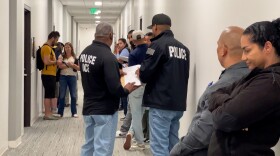San Diego County voters were almost evenly divided over Measure G, a half-cent sales tax increase that would have raised hundreds of millions of dollars each year for public transit, highways and local streets. But with nearly all votes counted, 51% of voters said "no."
The measure's failure is a blow to the coalition of environmental groups, labor unions and construction businesses that poured significant resources into getting the measure on the ballot and convincing voters to support it. And it's a victory for conservative groups that argued SANDAG, the planning agency that would have managed most Measure G projects, cannot be trusted with more money from taxpayers.
A KPBS analysis of precinct-level data published by the county Registrar of Voters found if Measure G had been limited to the city of San Diego, it would have passed with 54%. Precincts that overlap with the UC San Diego campus, which saw a new trolley line open since the last presidential election, saw some of the widest margins of support for Measure G.
Measure G also won majorities in the South Bay and the downtown areas of suburbs like El Cajon, Escondido and San Marcos. But the further a voter was from a dense population center served by public transit, the less likely they were to support Measure G.
SDSU political science professor Brian Adams said a range of factors likely contributed to Measure G's defeat. Inflation makes voters less inclined to support higher taxes, he said. And Measure G had competition from other tax measures on the ballot — most notably Measure E, a one-cent sales tax to support the city of San Diego's general fund.
Ultimately, Measure E failed by almost exactly the same margin as Measure G.
"I would hypothesize that many voters voted for one, but not the other because they figured two sales tax increases are too much," Adams said. "Even though (Measure G) won in San Diego… it needed to win by more to counteract some of the opposition outside of the city."
Adams added that the presidential race between Kamala Harris and Donald Trump "sucked all the oxygen out of the room" and made it difficult for any down-ballot race or measure to gain traction.
"Typically supporters of these measures like to put them on the ballot during a presidential race because you get higher turnout, and typically when you get higher turnout, it's better for these tax measures," Adams said. "In this particular year, it may not have necessarily benefited because turnout among Democrats wasn't all that great, and turnout among Republicans was actually stronger."






